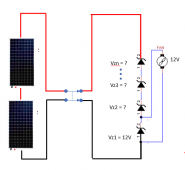You can get 100V 50W zeners stud mount. Mount 5 to an aluminum finned heat sink. I would think the zeners would only need to clamp the voltage for a few minutes at most.
The Zeners will have to clamp the voltage for as long as the batteries are full and the SCC is not taking current....or till the temperature of the panels rise and the Voc goes down.
I would not count on the temperature rising fast enough so the system needs to be designed for a sustained period of the zeners conducting. However, if the zeners are in the same cold temperature, the heat sinks will be much more effective. (This is an argument for putting the zeners at the panels, not at the SCC like my previous diagram)
BTW: The Zeners do not have to be all be the same voltage, You could have one at 12V to run a fan, several at a high voltage to take the bulk of the energy, and one final one to 'trim' the trigger voltage. The power rating for each one is determined by Vz x I, so the lower voltage zeners do not have to be as high wattage as the
lower higher voltage ones.
Also, it may be better (lower cost?) to use more lower voltage, lower wattage zeners than to use fewer high voltage, high wattage zeners.
The cost, number, voltage, and wattage of the zeners can all be adjusted to optimize price and performance.






